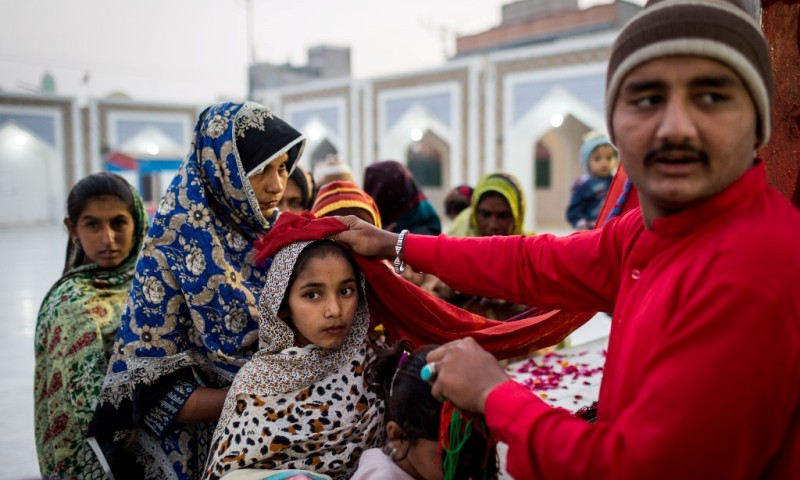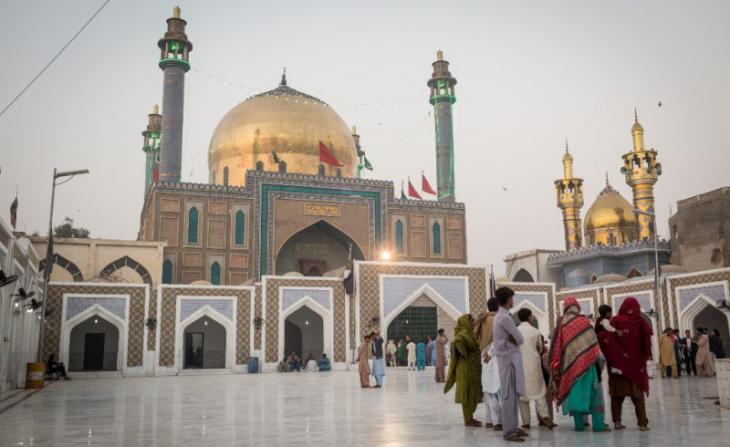Defying the extremists

As hundreds of pilgrims mill around, a sudden and loud intonation pierces the air: "Nara-e Haideri!" The mirror-work that decorates the ceiling of the great hall amplifies every sound in the sanctum of the shrine. Only a few dozen respond. But they react to the invitation to call Imam Ali by his name with a resounding "Ya Ali!", "Oh Ali!"
It is almost as if nothing had ever happened at the shrine of Lal Shahbaz Qalandar, the ruby-clad Sufi of Sehwan Sharif in Pakistan, who died here in 1356. Yet on the evening of Friday, 16 February 2017, just as the pilgrims were in the middle of their ritual dance, an Islamic State mercenary entered the shrine and set off his deadly package of explosives in the midst of the pilgrims. At least 88 people were killed and hundreds were injured. This place, which for centuries has been famous for its tolerance and peaceful atmosphere, became a death trap. "I was just few minutes away from the shrine and ran over there as soon as I heard the explosion," says Roshan Ali, who works at a guest house for pilgrims in Sehwan Sharif.
Up to one million pilgrims visit the small city every year. The slender man with the neatly trimmed moustache chooses his words very carefully, but doesn't quite manage to conceal his anger. "We looked after the injured, and when the police came, we thought that they would help us. But our hopes were dashed when we saw that they were only taking wallets and watches off the dead and looting surrounding jewellery shops that had been abandoned in the panic."
Peace and tolerance
The attack had been possible for the simple reason that in 660 years, the shrine of the Shia Sufi saint had never before been targeted. The very next day, the Sufis were back, once again engaging in the rhythmic dances and chants that bring them closer to their desired unity with God. No one wanted to give Islamic State the feeling that it had won.
"As a sign of defiance and in order to preserve the reputation of Sehwan as a place of joy and peace, we immediately carried on," says Roshan Ali. Many of the pilgrims I met during my visit see things in a very similar light.

Mumtaz and Siddra are two elderly ladies from the province of Sindh, who have spent a full day travelling to Sehwan Sharif. It is their very first visit. I ask them whether they are in any way nervous about visiting the shrine one year after the attack. "Why should we be afraid? This place has always been known for its tolerance and love. We are not going to be intimidated by one incident. We thought: now, more than ever, is the right time to come."
"Hostages to the flutes"
Every evening, after sunset, several hundred people in the inner courtyard of the shrine are entranced by the drumbeats and become "hostages to the flutes". If you didn't know any better, you might think you were in a night club somewhere in Europe.
Legs are in constant motion; arms are thrust to the left, to the right, up and down. Very soon, beads of perspiration appear on the men's foreheads and their traditional Pakistani clothes are stained with sweat. The dances are punctuated with loud calls to their venerated imams: "Ya Ali!" shouts out one man, "Ya Hussain!" another.Only a few metres further on, within sight of the dancing men, stand a group of women seeking unity with God in a similar way. After the ceremony, which lasts about two hours, many of them will claim to have been possessed by the spirits of dead relatives or saints. They rhythmically pound their chests or swing their long hair round in a circle, as if they were at a heavy metal concert. For most Muslims outside Sehwan Sharif, in a country as conservative as Pakistan, all of this is inconceivable and seems incompatible with Islam.
Devout believers with different values
Sehwan Sharif's reputation stretches far beyond the borders of the province of Sindh, where the city is situated. This is all the more astonishing because the city is home to just 100,000 people and apart from the shrine, it has nothing to attract visitors. But it is exactly because people in Pakistan have to live their lives according to very clear rules that Muslims and even some of the few Hindus that live in Pakistan, come here so that they can be who they are – devout believers with different values – in peace.

No Shia Muslim in Pakistan would publically acknowledge his love for Imam Ali and no follower of a Sufi order would ever openly say that they pray not only to Allah and Muhammad but also to the holy, deceased masters of their order. For many conservative Muslims who adhere to orthodox schools of law, these practices are haram, rituals that are forbidden and despised in Islam and which have already cost countless people in Pakistan their lives.
In a country where over 97% of the 200 million inhabitants are Muslim, sectarian violence is one of Pakistan's biggest problems. Sehwan Sharif may be the best-known place in Pakistan where this problem does not even exist. The Shias in particular are aware of this and flock to the shrine.
The traditional beating of the chest – something that is otherwise only done during the Muslim month of mourning, Muharram – is a daily occurrence at the shrine. When pilgrims pound their chests with the full force of their hands, it sounds like thunder. Directly alongside, people pray peacefully; women pray with men, while children run across the clean marble floor.It is not like this all over the country. Most Pakistani Muslims live out their religion, regardless of their orthodox Hanafi beliefs, very peacefully. However, several thousand people in the country are willing to go beyond words in their defence of their personal interpretation of Islam, thereby keeping the rest of country hostage for fear of a wave of violence.
But back to Sehwan Sharif. Ghulam Shabbir Khairpur has also come on a pilgrimage to the shrine. The business man from the northern part of the province has been coming here for many years. In the midst of all the people dressed in traditional Pakistani clothing, Khairpur, who is in his mid-fifties, really stands out in his neat suit and tie. "I'm not a member of a Sufi order, but I always like coming here. Here, it doesn't matter a bit what you are. Everyone is welcome here and last year's attack has done nothing to change that. I would come back here again and again, just to enjoy the atmosphere."

We cannot rely on the state
Many of the city's inhabitants and visitors share this view: the attitude to life in the city has not changed at all; the attack was merely a stark reminder that the freedom of this city is still embedded in a Pakistani context, in other words, in a country where there will always be a few religious extremists who do not tolerate any other opinions; a country where some policemen take advantage of the panic and chaos in the aftermath of an attack not to help but to loot.
Roshan Ali puts a long piece of cloth over his head and chest. Sometimes temperatures here barely climb above freezing point at night. From the roof of the guest house where he works, he can see the immaculate golden dome of the shrine.
The architecture and design of the shrine was inspired by the shrines in the Iraqi cities of Najaf and Karbala, the holiest cities for Shia Muslims. A bonfire illuminates his face as he mulls over what has changed for him since the attack. "We have always stuck together; one year after the attack, we are doing so more than ever. At the same time, we are more aware that we cannot rely on the state. We have to help ourselves."
Only one part of the clean, bright marble floor stands out from the rest: in between the shrine and the main entrance, there are dozens of black, marble-sized pockmarks. "These are the only traces of the attack that you can still see. The rest of the damage was quickly repaired, but we left those marks in the ground as a reminder."
Philipp Breu
© Qantara.de 2018
Translated from the German by Aingeal Flanagan
